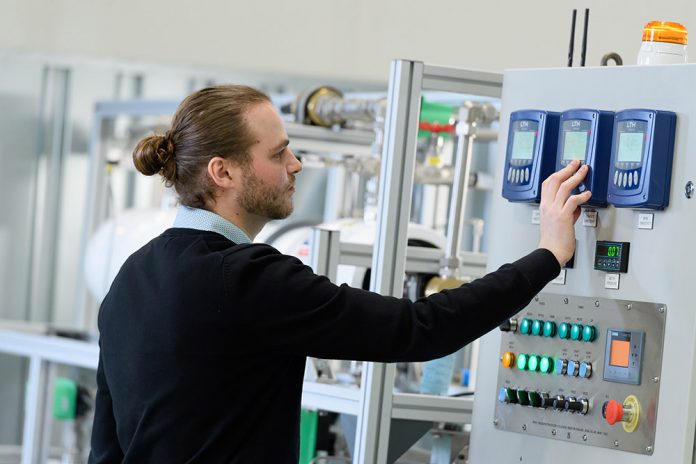The detrimental impact of excessive phosphorus concentration on water ecosystems, leading to harmful algae blooms, is a well-recognised environmental challenge. It has become a major environmental challenge for water companies and local government. Salinity Solutions successfully conducted a field trial with Wessex Water and Somerset Council in the summer, demonstrating how their pioneering technology could help overcome the problem, as Tim Naughton, co-founder and Chief Technical Officer, explains.
This mobile, energy-efficient and chemical-free wastewater treatment technology is the result of ten years of development at Aston University and the University of Birmingham. Our patented low-carbon technology recovers freshwater from wastewater and is the first commercial Batch Reverse Osmosis in the world. It’s the most efficient type of Reverse Osmosis technology available today, as it reduces energy consumption by 50% compared to competing technologies while recovering up to 98% freshwater.
Alongside Somerset Council, Salinity Solutions have been working on a new approach to remove excess nutrients from the environment. With the help of Wessex Water, this summer we undertook the first trial of the system as a method to resolve phosphorus contamination, unlocking housing projects and nature restoration programmes.
Once government funding was secured, Salinity Solutions delivered a no-cost trial for Somerset Council in July, to demonstrate the efficacy of our modular water treatment units. With the support of Wessex Water and its manufacturing partner Te-Tech Solutions, a unit was placed at the Fivehead Wastewater Treatment Works near Taunton for two weeks, allowing independent water sampling to be undertaken. A DEFRA minister and the local MP attended, along with teams from the Environment Agency and Natural England.
Independent results in August showed that 98% of phosphates and 88% of nitrates were removed from the treated sewage effluent.
In September, we presented our results to the Planning Advisory Group (PAS, representing Local Planning Authorities affected by nutrient neutrality), DEFRA, Environment Agency and Natural England.
Traditional phosphorus removal techniques, both biological and chemical, require significant investment and carbon-intensive civil infrastructure. Dosing with large volumes of ferric compounds is a widespread practice. In contrast, our rapidly deployed mobile plug-and-play chemical-free systems can operate alongside nature-based solutions such as reed beds, which typically take 2-3 years to establish and require large areas of land.
Batch Reverse Osmosis marks a major step forward in water treatment, giving water companies a highly effective new tool to tackle water contamination. The benefits include:
Convenience: in a single-stage operation it can remove phosphorus, nitrogen, PFAS, heavy metals, microplastics, viruses and bacteria.
Compact and deployable: the technology is housed in a 20-foot container and delivered on the back of a HIAB lorry, for rapid installation at wastewater treatment works, even in small remote rural sites.
Cost-effective: The traditional cost of traditional phosphorus removal techniques is high and ultimately passed on to new homeowners or bill payers. The cost of a single ‘P credit’ (equating to one kg of Phosphorus being removed in a year), was reported by Somerset Council in 2022 as over £54,000. Our technology, which doesn’t require new infrastructure or land acquisition, dramatically reduces the cost of P credits by a factor of at least four. Our SAM50 system can be provided as a long-term solution but will be particularly attractive as an immediate short to medium-term measure to achieve nutrient neutrality pending the planned national upgrade of existing wastewater treatment works by 2030 and as a permanent measure to smaller rural wastewater sites, where it is not economically viable to make costly upgrades.
Energy efficient: The system uses >50% less energy than comparative membrane technologies. It can be deployed in rural areas on a domestic power supply or supplemented by wind or solar power.
Chemical-free: Dosing with Ferric Chloride is the most used method of phosphorus removal at wastewater treatment works. As legislation around phosphorus tightens, the daily tonnage of chemicals required has risen dramatically, increasing the number of delivery journeys and the iron load going into rivers.
Nutrient reuse: the waste stream from the system is a concentrated nutrient brine which can be turned into a pelletised fertiliser product. During this process the remaining water is recycled, helping to make this a sustainable, closed-loop process.
Our batch reverse osmosis technology could rapidly address the twin problems of nutrient and water neutrality in the UK, accelerating natural habitat restoration. The Somerset trial has proven the technology can successfully remove phosphorus and has the potential to encourage nature recovery and unlock thousands of housing projects held up by legislation in ‘nutrient neutrality’ catchment areas.
Salinity Solutions is an engineering tech start-up and University of Birmingham spin-out, which has developed a unique batch reverse osmosis water purification technology using half the energy of traditional methods. Its patented, commercially viable solution has been described as the biggest step forward in water treatment in 50 years.




